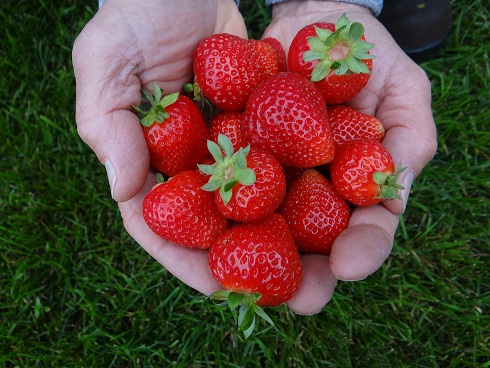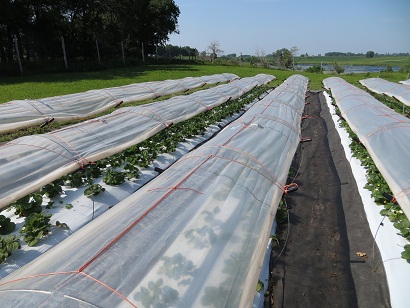Extending the day-neutral strawberry season using low tunnel production systems
Learn research results to extend the availability of locally grown strawberries by growing day-neutral strawberries using low tunnel production.
Availability of locally grown strawberries is extremely limited in the Upper Midwest, primarily due to the short growing season. Market farmers growing strawberries are limited to a very short harvest season, because traditionally the most successful varieties for field production in our region are June-bearing types. Newer day-neutral strawberry varieties, coupled with novel production methods, may offer growers the option of a longer harvest season using environmentally responsible methods.
For the last two years, our research objective was to conduct day-neutral strawberry trials using an organic low tunnel production system. To make fresh, locally grown strawberries available for an extended season, we established six day-neutral strawberry cultivars in raised beds using plasticulture with and without tunnels. We harvested day-neutral strawberry fruit from mid-July through mid-October in 2013 and 2014 at the University of Minnesota West Central Research and Outreach Center (WCROC) Morris site, the University of Minnesota St Paul campus site, and two farmer-cooperator sites.
A second objective was to use our research and innovative growing techniques to educate current and potential growers on these new strawberry production methods. If successful, this new method of growing long-season strawberries may help increase the number of strawberry growers in the Upper Midwest, increase yields and therefore availability of locally grown strawberries from June through October.
Day-neutral strawberry varieties produce flowers and fruit continuously when temperatures are optimal for plant growth. Older varieties have performed poorly (low yield and fruit quality) in our region, as concluded by research at the U of M (Luby, et al. 1987; Luby, 1989). However, with newly released varieties and newer technologies, fruit quality may be higher. Recent USDA research on day-neutral strawberry varieties grown under low tunnels resulted in increased yields of high quality fruit when compared to open-field-grown plants, with reduced incidence of bacterial and fungal diseases, fewer weeds, and reduced water use (Lewers, 2012).
Traditional June-bearing strawberry varieties in Minnesota have a baseline yield of 6,160 kg/ha. Preliminary data from USDA low tunnel trials calculated yield for day-neutral varieties varying between 9,632 kg/ha and 21,280 kg/ha (Lewers, 2012). Average 2013-2014 yield under low tunnels was 19,174 kg/ha at the St. Paul site and 24,398 kg/ha at the WCROC site; both within the USDA benchmark and also exceeding June-bearing strawberry varieties in Minnesota. As a comparison, average 2013-2014 yield in the non-low tunnel treatment was 16,948 kg/ha at the St. Paul site and 19,331 kg/ha at the WCROC site.
A comparison yield trial with Tribute, an older day-neutral variety, was completed in 2013. The six comparison strawberry varieties were Monterey, Evie-2, Albion, Portola, San Andreas and Seascape. Tribute, grown in a low tunnel, was comparable in yield at 22,986 kg/ha and comparable in pounds/plant at 0.51 kg. The individual berry weight was extremely small at 6.6 g average berry weight. Average berry weight for the six day-neutral cultivars was 16.5 g at WCROC and 12.9 g at St. Paul, which is a considerably larger fruit size. The cultivars we trialed using newer technologies have proven to be superior over older varieties.
Data was also calculated to determine the average yield per plant over the duration of the 2013-2014 harvest seasons. The commercially acceptable yield per plant for day-neutral cultivars is 0.45 to 0.68 kg per season. The six day-neutral cultivars grown under low tunnels averaged 0.54 kg per plant at WCROC and 0.44 kg per plant at St. Paul. The non-low tunnel averaged 0.43 kg per plant at WCROC and 0.39 kg per plant at St. Paul.
In order to determine individual size of fruit (g) of each cultivar, we randomly chose 20 berries per treatment at each harvest in 2013 and 2014. At WCROC, the average berry weight (g) across six cultivars for both years under the low tunnel was 16.5 g, while the non-low tunnel averaged 15.2 g. At St. Paul, the average berry weight (g) across six cultivars for both years under the low tunnel was 12.9 g, while the non-low tunnel averaged 12.4 g. By comparison, 2010-2011 data from the WCROC June-bearing variety trial shows the average berry weight was 11.5 g per individual fruit. After two years of research, the six day-neutral cultivars prove to have larger individual fruit size when compared to June bearing strawberry trials in Minnesota.
| Cultivar | Average yield per plant (kg) | Average yield (kg/ha) | Average weight per berry (g) |
|---|---|---|---|
| Monterey | 0.49 | 21,213 | 13.27 |
| Evie | 0.53 | 22.985 | 12.77 |
| Albion | 0.43 | 18,982 | 13.19 |
| Portola | 0.45 | 19,962 | 13.39 |
| San Andreas | 0.39 | 16,917 | 13.82 |
| Seascape | 0.35 | 14,983 | 11.41 |
| Cultivar | Average yield per plant (kg) | Average yield (kg/ha) | Average weight per berry (g) |
|---|---|---|---|
| Monterey | 0.40 | 17,424 | 12.72 |
| Evie | 0.50 | 21,646 | 11.93 |
| Albion | 0.34 | 14,890 | 12.22 |
| Portola | 0.45 | 19,686 | 13.38 |
| San Andreas | 0.34 | 14,819 | 13.82 |
| Seascape | 0.31 | 13,222 | 10.42 |
| Cultivar | Average yield per plant (kg) | Average yield (kg/ha) | Average weight per berry (g) |
|---|---|---|---|
| Monterey | 0.53 | 23,599 | 15.84 |
| Evie | 0.53 | 23,655 | 15.98 |
| Albion | 0.48 | 21,309 | 16.71 |
| Portola | 0.74 | 33,190 | 19.26 |
| San Andreas | 0.45 | 20,294 | 16.80 |
| Seascape | 0.54 | 24,338 | 14.11 |
| Cultivar | Average yield per plant (kg) | Average yield (kg/ha) | Average weight per berry (g) |
|---|---|---|---|
| Monterey | 0.38 | 17,157 | 15.21 |
| Evie | 0.49 | 21,857 | 14.62 |
| Albion | 0.40 | 17,981 | 15.94 |
| Portola | 0.56 | 25,039 | 16.31 |
| San Andreas | 0.36 | 16,032 | 16.57 |
| Seascape | 0.40 | 17,923 | 12.66 |
Hourly temperature and relative humidity were recorded at the Morris site in 2013-2014 using WatchDog A-Series data loggers in the low tunnel and non-low tunnel beds. The data loggers were suspended 30.48 cm (12 inches) above both beds. Observations from data loggers showed temperatures in the low tunnel were normally higher during the heat of the day, as compared to non-low tunnel temperatures. Average temperature in the low tunnel was 1.8°C above the non-low tunnel bed in 2013. Average temperature in the low tunnel was 0.8°C above the non-low tunnel bed in 2014. This temperature data indicates that the temperatures averaged out to be very similar in both low tunnel and non-low tunnel treatments.
During the 2013 late summer/fall picking season at the WCROC site, we tasted a noticeably sweet strawberry. We randomly took brix/sugar levels during the picking season of all six cultivars in the low tunnel and non-low tunnel treatments. The results showed an average brix level of 7.6 between late July and early October in both low and non-low tunnel treatments. In order to compare these brix levels, we randomly took readings in our 2013 WCROC June-bearing variety trial between late June and early July; the results showed an average brix level of 7.7. This comparison shows that day-neutral cultivars are just as sweet as June-bearing cultivars commonly grown in Minnesota.
We tracked all costs on the low tunnel day neutral strawberry system during the 2014 growing season at the WCROC site. Our low tunnel plot was 12 rows wide by 30.48 m (100 ft) long. The table below breaks down our total variable costs (labour not included) into the cost per 30.48 m row. By comparison, the non-low tunnel system cost was $69.50 per 30.48 m row, largely because it did not require greenhouse film, stainless steel support rods, spring tensioners, anchors, ropes or stoppers.
| Variable costs | Cost per 30.48 m or 100 ft row |
|---|---|
| Fertilizer | $11.67 |
| Herbicides, Insecticides, Fungicides | $2.78 |
| Plants | $25.00 |
| Irrigation-drip tape | $2.22 |
| Mulch-Plastic (White on Black) | $5.00 |
| Greenhouse Film | $144.00 |
| Stainless Steel Support Rods | $58.00 |
| Straw (for walkways) | $9.33 |
| Spring tensioners, anchors, ropes, stoppers | $21.00 |
| Tractor Fuel (tillage, bed preparation, plastic laying) | $3.50 |
| 1 lb. plastic qt. containers | $10.00 |
| Total Variable Costs | $292.50 |
With any fruit crop, it is important to monitor and routinely check for insects and diseases. We monitored for SWD adults with traps baited with apple cider vinegar, yeast and flour bait. We discovered female SWD in our day-neutral strawberry plot at Morris on September 29, 2014. No SWD have been found at the St. Paul day-neutral strawberry site.
In addition to checking for SWD, we monitored for two-spotted spider mites. Damage from two-spotted spider mites was detected prior to harvest on the leaves of day-neutral strawberry plants under the low tunnel system at Morris in late July 2014. No mites were found on the non-low tunnel treatment. While the damage was slight, it certainly came as a surprise since we did not experience this type of insect problem in 2013. Typically, the two-spotted spider mite is found in very warm environments, such as high tunnel systems or greenhouses.
During the August 2014 harvest period, we noticed fruit damage from western flower thrips only in the non-low tunnel treatment in Morris; we did not experience this issue in 2013. Thrips feed on strawberry blossoms, which causes the stigmas and anthers to turn brown and wither prematurely, but not before fertilization has occurred. As fruit develops, thrips feeding may cause a russeting or bronzing of the fruit.
Our method of controlling thrips was to apply Mycotrol, an organic approved insecticide (not registered on strawberries in Canada). This was applied every five days from mid- to late August before we saw an improvement in fruit quality.
In September 2014, we noticed strawberry leaf spot, a foliar fungal disease in the non-low tunnel treatment, but not in the low tunnel. Strawberry leaf spot has a bulls-eye appearance with a gray center on the leaves. This occurred at both the St. Paul and Morris locations. Portola was affected more than the other five cultivars we trialed but did not affect yield. For reasons unknown to us, the leaf spot affected only the non-low tunnel but not the low tunnel treatments.
For step-by-step instructions on constructing a low tunnel system for strawberry use, or for more information on the project, please visit our low tunnel strawberry blog at the UMN Commercial Fruit website. You can also look for Cold Climate Strawberry Farming, a free interactive e-book from UMN. The e-book goes into detail on important topics such as choosing your market, innovative marketing techniques, comprehensive cultivar recommendations, insurance requirements and other essential business information, and of course best practices for growing strawberries. Cold Climate Strawberry Farming covers June-bearing strawberry production in addition to the new, season-extending method that uses low tunnels and day-neutral cultivars. All content can be viewed online or downloaded for offline use to any iOS or Android mobile device.
Low tunnel day-neutral strawberry research at the UMN will continue into 2016. Steve Poppe can be contacted at poppesr@morris.umn.edu.

